This May, Dentsu Public Relations Inc.’ in-house thinktank, the Corporate Communication Strategic Studies Institute, carried out its second Internal Branding Survey of 1,000 businesspeople working at companies with 100 or more employees. The survey aims to measure what factors lead to increased employee engagement.
Key Findings
1.Over six in ten say they want to contribute to their company, but around half lack trust, a sense of attachment, and pride towards their place of work
- 61.1% respondents said they wanted to contribute to their company.
- However, only 48.4% said they trust their company, 50.1% said they felt a sense of attachment, and 51.1% said they were proud of their workplace.
2.High engagement group maintains motivation thanks to feeling well matched with the company’s purpose
- There was a large gap of over 50 points between employees with high and low engagement with their company across all areas of “systems and workplace,” “motivation to work,” and “internal communication.”
- There was a particularly large gap in items concerning motivation and relationships, such as “I feel that my vision for myself matches what the company is looking for” and “there is a culture of consideration between colleagues and subordinates.”
3.Over half of those reporting low engagement are considering quitting or finding a new job
- On the subject of how the COVID-19 pandemic has affected their feelings toward their company, over 20 points more respondents in the low engagement group said that they were less interested in their company and workplace and were considering quitting or finding a new job than did those with high engagement
4.Executive messages often ill-received amid pandemic, well-crafted communication necessary
- Only 27.9% reported a positive image of executive messages during the pandemic. A total of 52.9% said they found such messages unnecessary or frustrating.
5.Over 60% of the companies with high engagement are involved in SDGs initiatives
- Over six in ten (62.6%) of the high engagement group said that their company was involved either proactively or to a certain extent in Sustainable Development Goals initiatives. In contrast, less than half of the low engagement group responded in the affirmative (25.6%) .
Internal Branding Model
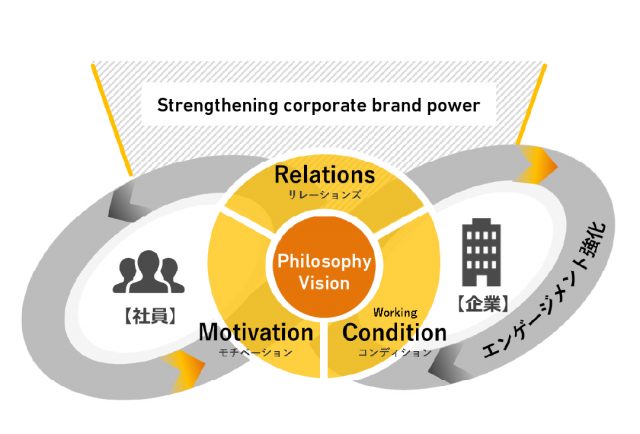
The second Internal Branding Survey was designed based on the Internal Branding model shown on the left.
The Japanese term for internal branding is a registered trademark of Dentsu Public Relations Inc. (See page 7 for more details) .
Results
In this survey, the “high engagement group” is defined as those who responded “agree” or “strongly agree” to all of the following sentiments toward their company: trust, a sense of attachment, pride, a desire to contribute. The “low engagement group” is those who answered “disagree” or “strongly disagree” to all areas. (Fig. 1)
Fig 1. Engagement
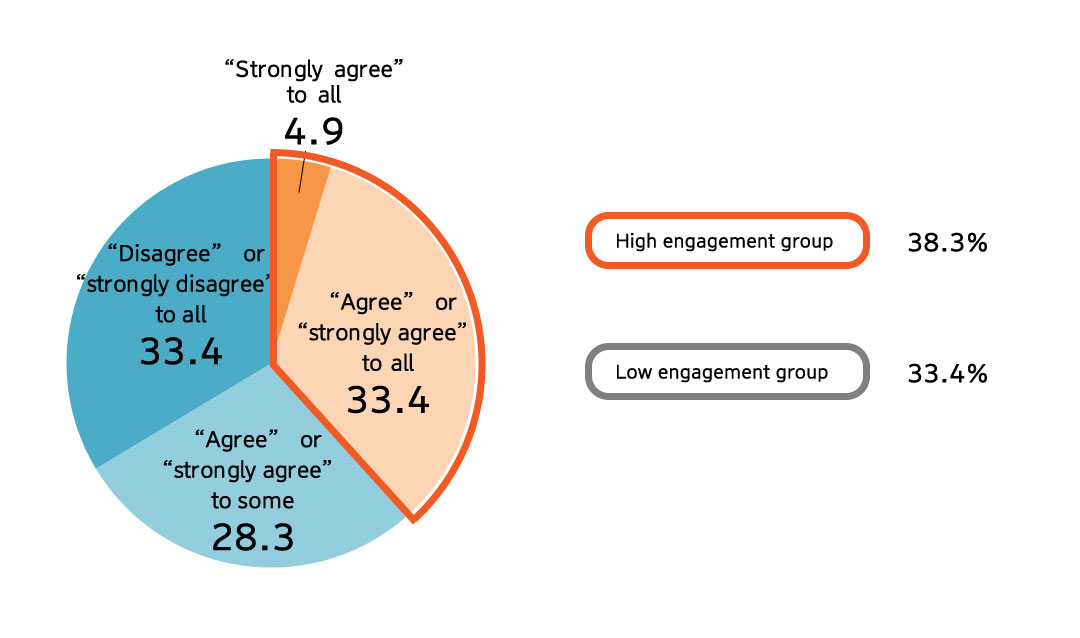
1.Over six in ten say they want to contribute to their company, but around half lack trust, a sense of attachment, and pride towards their place of work
Less than half (48.4%) of the 1,000 businesspeople surveyed said they trusted their company, with only 7.8% responding “strongly agree” and 40.6% answering “agree.”
Furthermore, only around half of respondents said they felt a sense of attachment (50.1%) or pride (51.1%), indicating that respondents were split fifty-fifty in terms of whether or not they felt trust, attachment, or pride towards their companies.
However, it was evident that over six in ten wanted to contribute to their companies, with a total of 61.1% answering “agree” or “strongly agree.” Roughly six in ten respondents also said that they wanted to continue working at their company (59.6%). [Fig. 2]
Fig. 2: Which of the following sentiments do you feel toward your company? (n=1000, single answer)
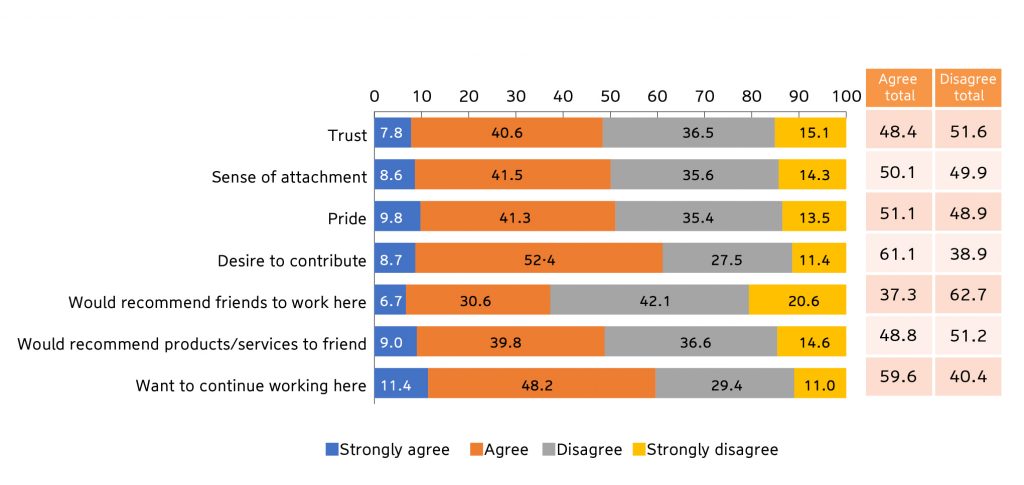
2.High engagement group maintains motivation thanks to feeling well matched with the company’s purpose
Respondents were asked about their company’s systems and workplace, motivation towards duties, and internal communications. There was a large discrepancy between the high and low engagement groups across all areas.
The largest gap was observed in the “motivation” category, concerning the statement “I feel that my vision for myself matches what the company is looking for.” Of the high engagement group, 77.2% said they agreed, in contrast to a mere 6.5% of the low engagement group. This indicated that the high engagement group feels like their work is a good match the kind of person they want to be.
There were also big gaps in aspects concerning motivation and relations, such as: “there is a culture of consideration between colleagues and subordinates” (70.4pt gap), “I feel a sense of achievement and personal growth through my work” (69.5pt gap), “I can do what I want and like through my work” (65.7pt gap). There was also a gap of 50pt or more across most of the other statements, indicating that they key to boosting engagement is keeping employee motivation high and fostering an amicable company culture. [Fig. 3]
It seems particularly important to boost employee motivation by making sure they are a good fit for the company’s purpose in order to foster trust, pride, and engagement toward the company.
[Fig. 3] Which of the following are true about your workplace, role, and internal communications? (n=1000, single answer)
*In descending order based on % of high engagement group that agree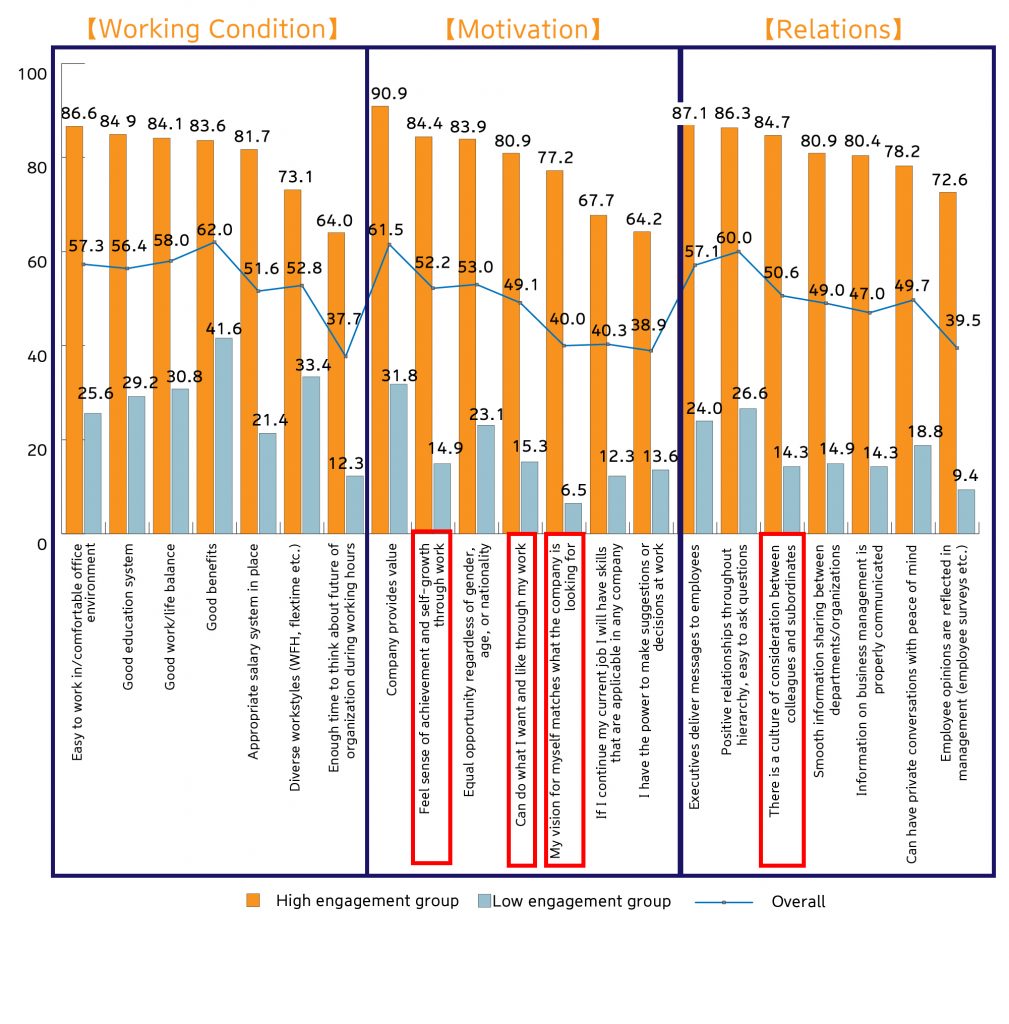
3.Over half of those reporting low engagement are considering quitting or finding a new job
Many people have currently seen the way they work transformed dramatically due to COVID-19. Against this backdrop, the survey asked respondents if the way they perceived their company had changed during the pandemic. It was revealed that the low engagement group had seen their trust in their companies shaken significantly in comparison to the high engagement group.
The statement that drew the biggest gap between the high engagement group and the low engagement group was “I am less interested in my company and workplace” (25.8pt gap). This was followed by “I have considered quitting or finding a new job” (24.8pt gap), to which over half (50.3%) of the low engagement group said they agreed, roughly double the proportion of the high engagement group (25.5%) that said so. There was also a big gap in the responses between the high and low engagement groups concerning the statements “there was not enough support for employees” (21.1pt gap) and “I have become worried about the growth potential and future of my company” (15.5pt gap). [Fig. 4]
It was clear that if there is strong engagement between employee and their company, trust of the company remains unshaken even in the face of crises like the COVID-19 pandemic.
[Fig. 4] How have you felt toward your company during the pandemic? (single answer)
*Total “strongly agree” and “agree”
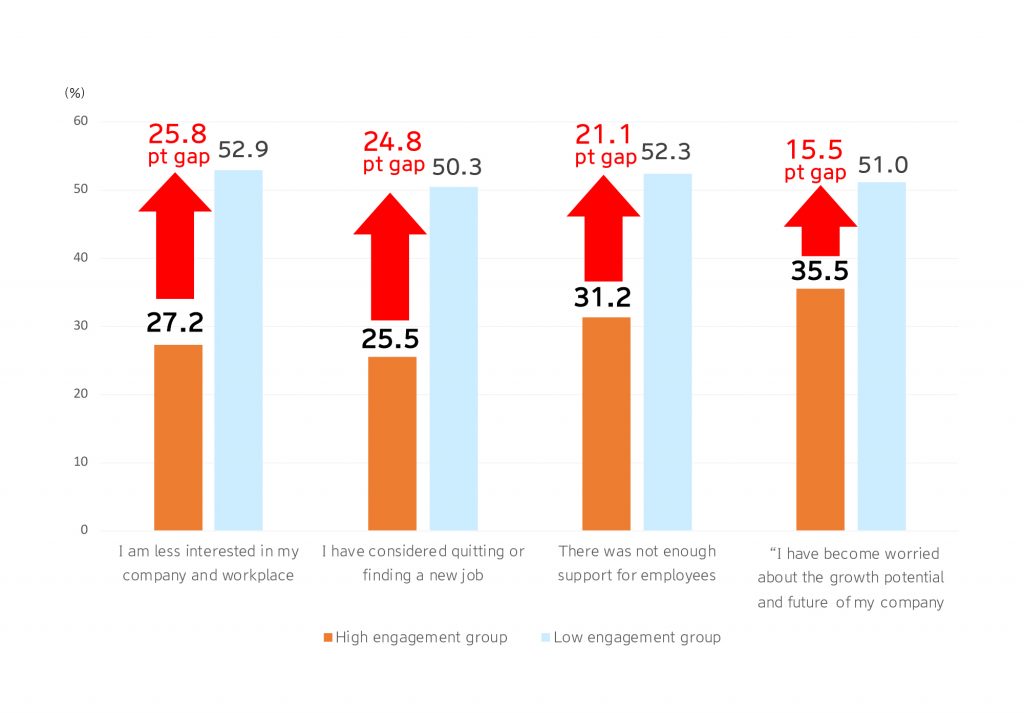
4.Executive messages often ill-received amid pandemic, well-crafted communication necessary
Respondents were then asked about how their companies handled the pandemic and the support they provided during it. They were asked about whether their company took certain actions, and if they did, how they felt about it.
Among “yes, and I felt positively” answers, the highest evaluated measures taken by companies, in order, were “changes to work styles (work from home, restrictions on going to the office etc.)” (32.5%), “encouragement and consideration from superiors” (28.7%), “optimizing work tasks” (28.5%), and “internal messages from top executives” (27.9%).
However, even though “internal messages from top executives” was the most widely implemented measure across the board, over half (52.9%) of respondents said “yes, but it was unnecessary” (39.5%) or “yes, but it was frustrating” (13.4%) [Fig. 5]
While executive messages to employees did receive a certain amount of positive feedback, it seems that these messages may be considered unnecessary depending on the words used and communication style. It appears important to deliver trustworthy messages even in states of emergency in order to increase the number of highly engaged employees who feel pride and attachment toward the company.
[Fig 5.] Did your company take the following actions during the pandemic? If so, how did you feel about them? (n=1000, single answer)
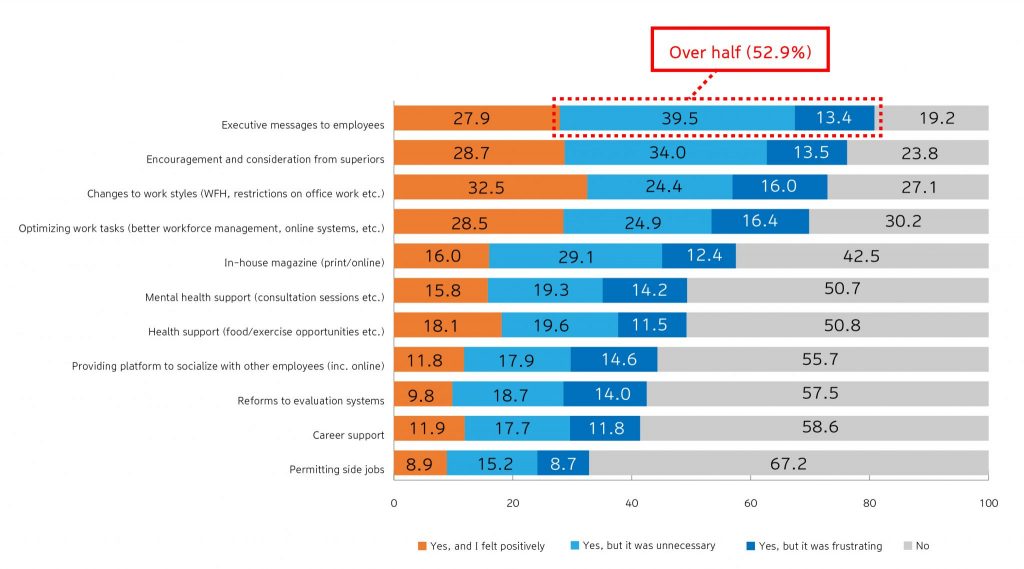
5.Over 60% of the companies with high engagement are involved in SDGs initiatives
Amid the COVID-19 pandemic, the value of companies is expected to change as the way they see themselves and the way they work change drastically.
When respondents were asked whether their company is working on SDGs initiatives, over six in ten (62.6%) said “yes, proactively” or “yes, to an extent,” over double the number of the low engagement group (25.6%) that said the same. [Fig. 6]
This demonstrates that working to resolve social issues boosts employee engagement and corporate social value. Additionally, conveying the social value of the company to employees should help boost engagement.
[Fig. 6] Is your company working on SDGs initiatives? (single answer)
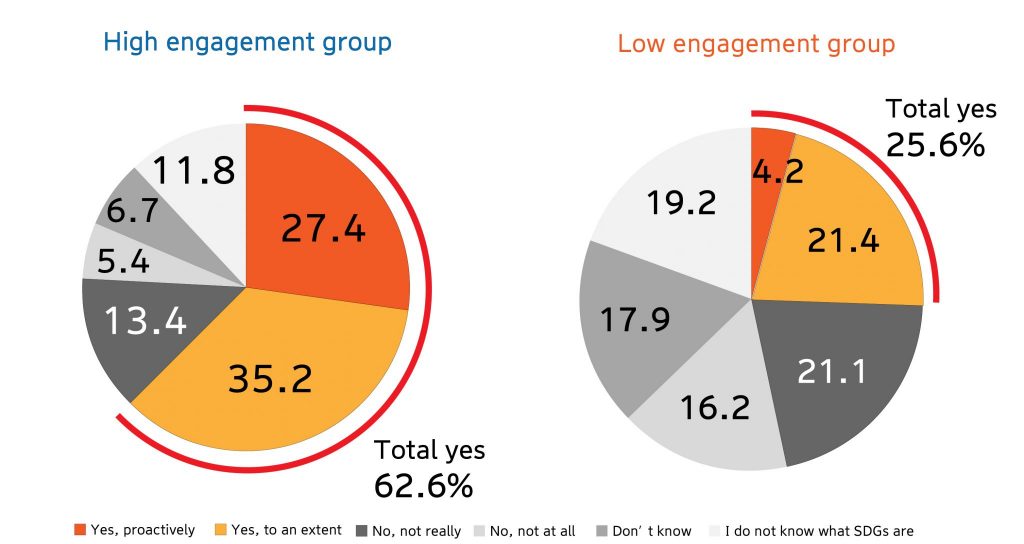
Internal Branding Model
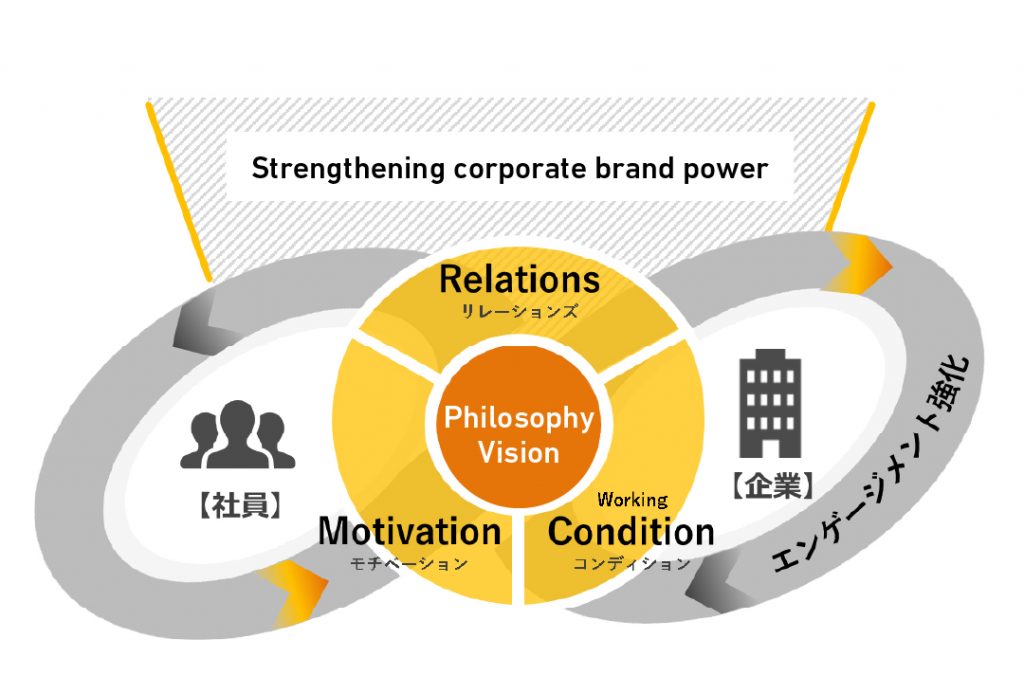
The Japanese term for internal branding has been a registered trademark of Dentsu Public Relations Inc. since 2003. The idea is to brand the company in a way that facilitates the sharing of challenges throughout the organization, have all employees take action toward the same vision with the same mindset, create the power to attract people, and boost organizational value.
Based on this approach, the CSI used its past experience and the results of the Internal Branding Survey to develop the Internal Branding Model. This model is based on the concept that the key driver strengthening engagement* is “philosophy” and that the three aspects of working conditions, motivation, and relations support that philosophy.
*In this release, engagement is the bond between company and employee. In the survey, it is defined in terms of “trust,” “attachment,” “pride,” and “contribution.” (see Fig. 1, p2)
Survey overview
Respondents: Businesspeople aged 20 to 69 from around Japan working in a company with 100 or more employees. Total 1,000 respondents, with 500 men and 500 women
Methodology/period: Online survey/May 21- 25, 2021
Content:
- Survey on the state of awareness of one’s company and its philosophy
- Relationship between perception of company and adoption of company philosophy
- Aspects of effective initiatives to address the above
- Communications tools that are effective at spreading corporate philosophy
- Support and handling of COVID-19 pandemic
- SDGs initiatives, etc.
*Data in the release has been rounded to the first decimal place. There may be discrepancies with the stated figures, for example, when calculating the difference between figures.
About the Corporate Communication Strategic Studies Institute (CSI)
Dentsu Public Relations Inc.’ internal think-tank. Conducts surveys, analysis, and research concerning corporate communications strategy and systems in partnership with business management and communications experts (university professors, researchers, etc.)
Established in December 2013. Director: Kanji Sakai
Corporate Communication Strategic Studies Institute Website http://www.dentsuprc.co.jp/csi/
Request
When copying or quoting the content of this survey, please do so under your own responsibility while clearly stating that these are the results of the CSI.
Internal Branding Survey Member Profiles
- Hifumi Chin, Senior Researcher, Corporate Communication Strategic Studies Institute
- Yoko Okawa, Senior Researcher, Corporate Communication Strategic Studies Institute
- Makiko Togami, Senior Researcher, Corporate Communication Strategic Studies Institute
- Tatsuya Ikui, Senior Researcher, Corporate Communication Strategic Studies Institute
